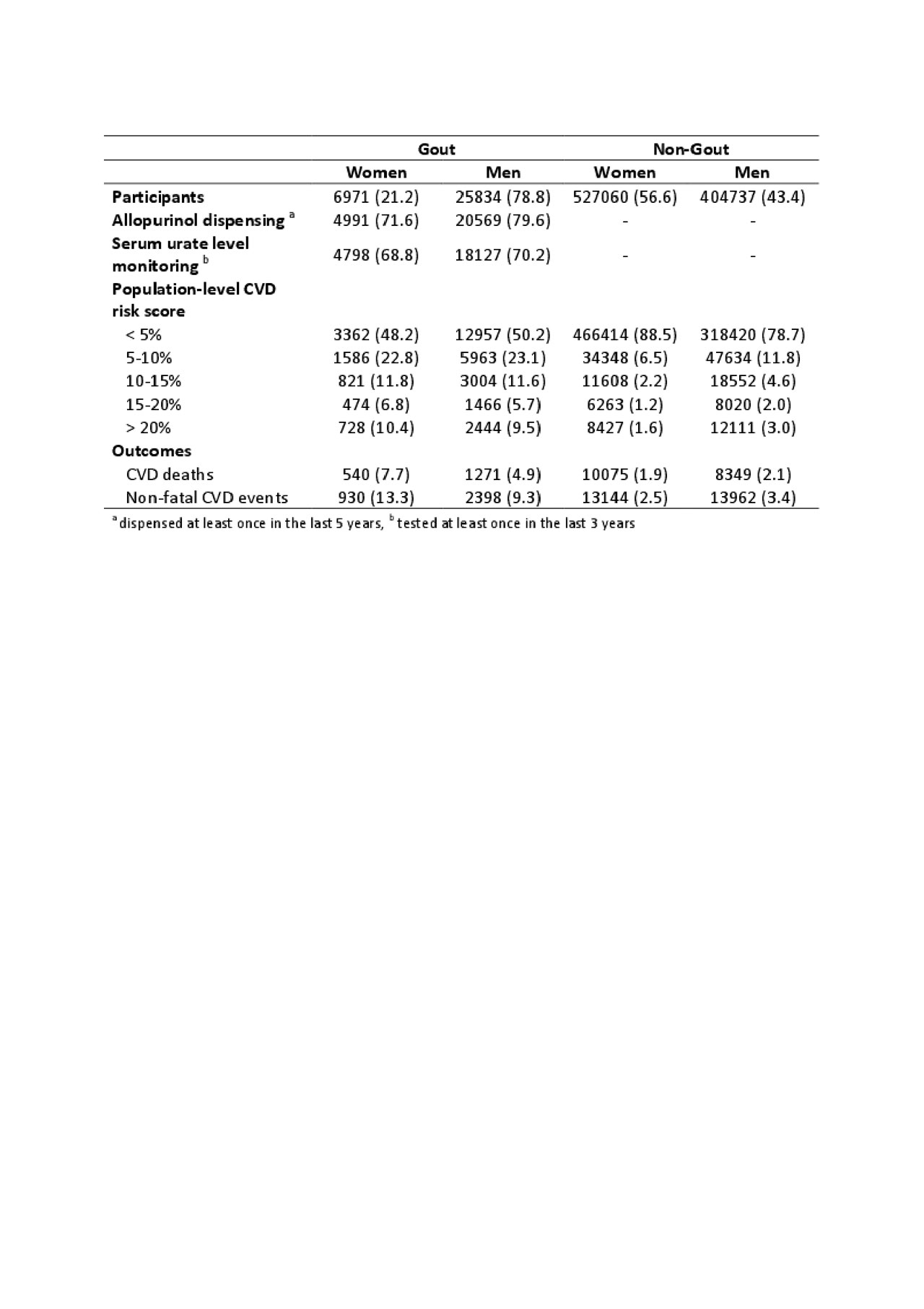Session Information
Session Type: Plenary Session III
Session Time: 11:00AM-12:30PM
Background/Purpose: Some studies have reported that gout is an independent risk factor for cardiovascular events. Furthermore, urate-lowering therapy such as allopurinol may be associated with reduced risk of cardiovascular disease (CVD). Recently, population-level cardiovascular risk prediction equations for health planning have been developed and validated using linked health data in New Zealand (Mehta, Int J Epidemiol. 2018). We examined the association of gout with population-level estimated CVD risk and CVD outcomes using linked national health data.
Methods: National registries of medicines dispensing data, hospitalisation, and death were linked to the Auckland/Northland regional repository of laboratory results from January 1, 2012 to December 31, 2016. There were 65.6% (n=968,986) of the resulting health contact population who had no prior CVD in 2012 and formed the cohort for this study. Sex-specific baseline 5-year CVD risk (of cardiovascular death, non-fatal myocardial infarction, stroke, or other vascular event) was derived using the published population-level CVD risk scores. A validated national health data definition of gout was used to define those with gout: discharge diagnosis of gout (ICD-9 274, ICD-10 M10) from a public hospital admission or having been dispensed gout specific medications (Winnard, Rheumatology 2012). Data were limited to patients aged ≥20 years with a primary residence in the Auckland/Northland region for the last 3 years.
Results: Of the 968 986 people included in the study, 32 805 (3.4%) had gout. The population-level estimated 5-year CVD risk and rates of CVD events (fatal and non-fatal) were higher in both women and men with gout (Table). After adjustment for age, gender, ethnicity, deprivation quintile and population-level estimated 5 year CVD risk, gout was independently associated with an increased odds of fatal (adjusted OR 1.37, 95% CI: 1.27-1.48) and non-fatal CVD events (adjusted OR 1.41, 95% CI: 1.35-1.47). Compared with people without gout, there was no statistically significant difference in adjusted odds ratio for those with gout dispensed allopurinol compared with those not dispensed allopurinol (for fatal CVD events, adjusted OR 1.38, 95% CI: 1.27-1.50 vs. 1.33, 95% CI: 1.14-1.55; for non-fatal CVD events, adjusted OR 1.41, 95% CI: 1.34-1.47 vs. 1.42, 95% CI: 1.31-1.54). There was also no statistically significant difference in adjusted odds ratio for those with serum urate above 6mg/dL or below 6mg/dL (for fatal CVD events, adjusted OR 1.38, 95% CI: 1.23-1.54 vs. 1.33, 95% CI: 1.13-1.55; for non-fatal CVD events, adjusted OR 1.50, 95% CI: 1.42-1.59 vs. 1.35, 95% CI: 1.24-1.47), when compared to people without gout.
Conclusion: Gout is associated with an increased estimated risk of CVD events calculated from population-level cardiovascular risk equations. Even after adjustment for estimated 5 year CVD risk and additional weighting of risk factors within it, gout independently increased the odds for fatal and non-fatal events. This effect was not ameliorated by allopurinol use or serum urate lowering to treatment target.

Gout and CVD outcomes – ACR Abstract Table
To cite this abstract in AMA style:
Cai K, Wu B, Mehta S, Dalbeth N, Jackson R, Katrina P. The Relationship Between Gout and Cardiovascular Disease Outcomes: A Health Data Linkage Study of 1 Million New Zealanders Using Population-level Cardiovascular Risk Prediction Equations [abstract]. Arthritis Rheumatol. 2019; 71 (suppl 10). https://acrabstracts.org/abstract/the-relationship-between-gout-and-cardiovascular-disease-outcomes-a-health-data-linkage-study-of-1-million-new-zealanders-using-population-level-cardiovascular-risk-prediction-equations/. Accessed .« Back to 2019 ACR/ARP Annual Meeting
ACR Meeting Abstracts - https://acrabstracts.org/abstract/the-relationship-between-gout-and-cardiovascular-disease-outcomes-a-health-data-linkage-study-of-1-million-new-zealanders-using-population-level-cardiovascular-risk-prediction-equations/
